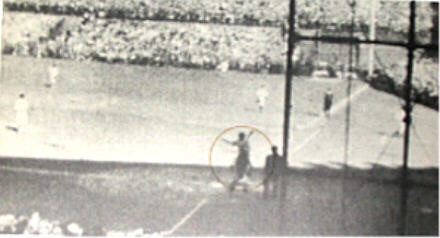The setting was the fifth inning of Game 3 of the 1932 World Series between the Chicago Cubs and the New York Yankees, held at Wrigley Field in Chicago. Legend has it that Yankees star Babe Ruth stepped to the plate and pointed it to the center field flagpole as if to say to the Chicago team, the 50,000 rowdy fans, and pitcher Charlie Root, that flagpole is my target. He then delivered on his target-setting gesture by hitting the ball 440 feet to the deepest part of the field near the flagpole for a home run.1

Babe Ruth Signaling Target of the Next Pitch2
While there has been much debate around if the “called shot” was real or not3, the “target setting” lessons are still relevant. Babe Ruth had credible baseline data from his batting average, had the best practices honed sharply over many games that season and knew what his required level of performance had to be in order to make good on his target attainment.
As Kaplan (2006) reminds strategy builders, articulating strategy and identifying strategic objectives often get the spotlight as major scorecard-building challenges. But defining Key Performance Indicators and setting targets are no less challenging—for different reasons. And unlike the more stable Balanced Scorecard (BSC) elements, targets must, by definition, be continually revised. One of the most delicate tasks is setting effective targets—those that are ambitious, yet achievable without being demoralizing. The implications are great, not just for organization performance but for individual performance and morale.4
Niven (2006) posits that the strong human desire to meet a predetermined goal has been with us from time immemorial. Many centuries ago, Seneca said, “If a man knows not what harbor he seeks, any wind is the right wind.” Oliver Wendell Holmes weighed in on the subject with this piece of wisdom: “The great thing in this world is not so much where we are, but in what direction we are moving.” Seneca and Holmes were erudite gentlemen, but their advice can’t compete with this pearl from that wisest of all sages, Yogi Berra: “If you don’t know where you are going, you might wind up someplace else.” Although these quotes represent vastly different times, places, and perspectives, what they have in common is the focus on a future destination, in other words, a target.5
First the fundamentals. Performance levels are interpreted using targets, the desired level of performance for a specific reporting period, and thresholds, the upper and lower limits of desired performance around a target value. Thresholds create the exact points where an indicator displays green for good performance, yellow for satisfactory or red for poor. Targets and thresholds are not arbitrary. They’re based on current baseline data, best practices results, a required level of performance to achieve an enterprise-wide goal, or other logical comparatives. Some organizations think of target in terms of hitting a single number; others look at average performance within a certain range. Niven (2006) states that every balanced scorecard needs targets5.
Getting to Targets
To get to a target, you start with a strategic objective with clearly defined intended results (for example, to improve quality), you then decide how to measure it (for example, by reducing waste), and then define a target for your KPI, (for example, reduce waste by 10%).
Marr (2014) states that considerable target setting research and target setting practice shows very clearly that targets need to be specific, and time bound. This specificity helps to define your desired target performance level and put a timeframe around the target to focus attention. When the target is specific, you remove any confusion or ambiguity and allow the people involved to know exactly where they are and where they are heading.6
Tips For Establishing Targets
Baselines are the most common basis for target setting, using historical performance levels to establish the normal, or “business as usual”, targets and thresholds. When no historical data is available, measure actual performance levels for several periods to create the baseline. The current baseline pattern has an impact on the most appropriate target level. For example, if the data is already naturally trending in a positive direction by 2 percent per period, target-setting should reflect that pattern.
At least seven data points are needed to statistically establish a trend. Plotting these points indicates whether the baseline is:
- Stable: showing no evidence of upward or downward trend lines
- Ascending or descending trending consistently in one direction or another
- Unstable or variable: illustrating no clear trends or patterns
Clearly on brand new targets, a time investment is necessary to gain the requisite data points for baseline evidence.
Benchmarking performance level against the best practices of the organization’s industry or another similar process enables comparisons between the two. According to Dr. Carla O’Dell of the International Benchmarking Clearinghouse/American Productivity and Quality Center (APQC), “Benchmarking is an alliance between two partners to share information on processes and measures that will stimulate innovative practices and improve performance. A process of finding and implementing best practices, benchmarking accelerates the rate of improvement by providing real world models and realistic improvement goals.”
Customer and compliance requirements also serve as measurement targets and thresholds. Service level agreements set performance expectations for both internal and external customers. Compliance and regulatory requirements, such as minimum safety levels for industrial plants and processes, or for airline safety, provide similar target-setting opportunities.
Other General Target Setting Tips
- Make sure to revisit your targets on a scheduled basis
- In a regular review cadence review the results of the KPIs at all levels now that the organization-wide strategy has been aligned (cascaded) to divisions or department. Make changes as needed to KPIs and, if needed, the targets.
- Communicate the results at the scheduled intervals throughout the organization
- Integrate strategy planning and performance management systems needed to inform decision-making through target attainment, a set of finely developed KPIs and a collection of strategic objects that present the overall strategy of organization, division/departments and individuals/teams that put the strategy in motion.
If you’d like to learn more about defining strategic objective, KPIs or target setting, please consider our KPI Professional certification course or contact us directly to speak with our consulting specialists in strategy development, implementation, and execution.
Sources
- Wikipedia. https://en.wikipedia.org/wiki/Babe_Ruth%27s_called_shot
- Wikipedia. https://en.wikipedia.org/wiki/File:Ruth1932-1.jpg
- Fernandez, G. (October 2020). Lou Gehrig confirmed Babe Ruth’s famous ‘called shot’ in the 1932 World Series in recently found audio clip – https://www.cbssports.com/mlb/news/lou-gehrig-confirmed-babe-ruths-famous-called-shot-in-the-1932-world-series-in-recently-found-audio-clip/
- Kaplan, R. (2006). Target Setting. Harvard Business Review.
- Niven, P. (2006; 2nd Ed.). Balanced Scorecard Step by Step – Maximizing Performance and Maintaining Results. John Wiley & Sons.
- Marr, B. (2014). 25 Need to Know Performance Indicators. Pearson Education Limited.
Joe is the Senior Vice President, as well as a senior consulting associate, who has 40+ years of extensive experience in business structuring, strategy formulation/implementation including balanced scorecard use, change management, and the design/execution of innovative operational business models/solutions in the private, public, and nonprofit sectors with first-line and executive level management positions.


